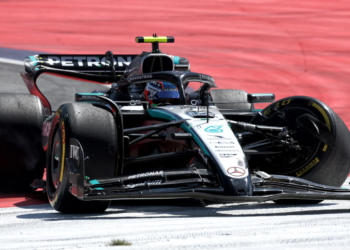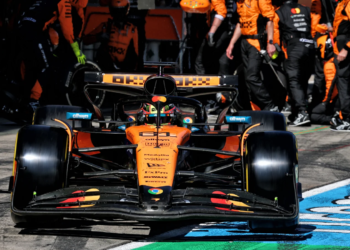Formula 2 chiefs say they have “started from zero” in a bid to get on top of two main issues that have plagued the championship’s new package, amid mounting criticism from drivers.
Formula 1’s feeder series introduced the Dallara-designed F2/18 for this season, complete with a new turbocharged engine, manufactured by usual supplier Mecachrome, following seven years of service from the GP2/11.
However, two primary issues have disrupted proceedings in 2018, with an unpredictable clutch system hurting the start procedure, and engine glitches hampering some drivers.
Several drivers expressed irritation, on the condition of speaking anonymously, with one quipping “we are paying for our seats [only] to be test drivers”, while another commented “it’s not a fight between drivers, it’s a fight between cars and [who] has the least problems.”
A handful of drivers cut an apathetic tone and expressed resignation over the situation, to the extent that they are “not frustrated anymore” and are almost expecting issues.
“We have to come together [with the series] to find a solution,” commented one, “because it’s also a safety issue.”
Motorsport Week sat down with Formula 2 CEO Bruno Michel and Technical Director Didier Perrin to explain the current situation in the championship.
The clutch
.jpg)
One very visible issue with Formula 2 this season has been the difficulty drivers have had in getting the car off the line.
This is understandably not supposed to be the simplest of tasks for drivers trying to prove their worth to Formula 1 teams – but the litany of stalls and varying getaways has affected the order at nearly every race.
One driver described it earlier this year as a “lottery”, while another pointed to the fact that series veteran Artem Markelov “has been here four-five years – he knows how to start a race,” referring to the Russian having stalled.
The clutch earlier in the year was extremely sensitive, with teams and drivers struggling to find the bite point.
This meant that drivers were encountering a huge variation in revs while sitting on the grid, a substantial increase on the GP2/11.
Gradual fixes were applied, reducing the fluctuation in revs, and the situation was better in Barcelona and, mercifully, Monaco, than it had been in Bahrain and Baku, though come France there was more strife, even if some drivers (starting near the back) did take liberties.
“We expected better results but in Le Castellet it was pretty obvious the problem was still there,” explains Perrin.
“Since that moment we put everything on the table and we started again from scratch. So now we are questioning ourselves on clutch and clutch control and engine characteristics at the precise moment of the start.
“But with the starts, on Monday morning, after Le Castellet, we started at zero.
“It’s so important that it was decided to reconsider everything, to make sure we consider everything, we worked day and night from Monday morning with engine manufacturer, clutch manufacturer, system manufacturer, and that’s what we’re doing now.”
.jpg)
Formula 2 chiefs were eventually able to organise an additional 15-minute session on Friday morning for practice starts, a move well-received after several pleas.
“We thought perfectly honestly that we thought we had sorted the issue before Paul Ricard and obviously that was not the case as we had a few cars stall on the grid,” Michel said.
“We’ve been working. The problem is we have three races back-to-back, that’s the big difficulty we have at the moment. We will see what the best thing is to do to make sure we don’t have safety issues, these are things we’re quite scared of, we don’t want to have a massive shunt on the grid, so we’ve been working on it and coming up with new solutions so let’s see.”
New sensors have been added to the F2/18 for this weekend’s Spielberg round, while concurrent programmes are ongoing behind-the-scenes for further updates to come at Silverstone, Budapest and beyond.
“[The main priority] is to make the clutch more progressive and easier to control for the driver,” outlines Perrin. “That’s the job we do on the clutch side. But as well we try to investigate what’s going on with the engine as we know that the engine… on the dyno it’s easy to measure the power delivered by the engine at full rev in a very stabilised situation, but it’s very difficult to know what torque is available at the precise moment at the start, and this is what we need to understand, to see and check if we have the torque that we expect to have.”
The engine
The clutch issue has taken preference but there remain problems with the new turbocharged engine, with reliability issues having compromised several drivers this season.
.jpg)
Most recently, title contenders Alexander Albon and George Russell were hampered at Paul Ricard, the DAMS driver losing third place in the Feature Race and the Mercedes-backed youngster unable to start the Sprint Race from eighth, having triumphed the previous day.
Other drivers also suffered with glitches throughout the course of the weekend.
“This was a pure reliability problem of one sub-component of the engine – the throttle motor,” confirmed Perrin.
Supplier Mecachrome has addressed the reliability issue in the days between Paul Ricard and Spielberg, with an updated component fitted to all 20 cars on Thursday evening.
“We identified what the problem was, we hope the solution we’ve come up with is the right one,” stressed Michel. “Normally we always try to put things on the development car before we put them on 20 cars on the grid but since the urgency is there we’re working slightly differently in a more pragmatic way, and we’ll see.”
Each engine is set to be sent back to Mecachrome after next weekend’s round at Silverstone for thorough checks prior to the following event at Budapest, taking advantage of the three-week break, with the championship not joining Formula 1 at the German Grand Prix.
Further frustration has been caused by the fact that issues are still arising at the mid-point of the campaign, having believed that the expected early gremlins had been addressed.
“It’s quite a complicated story but let’s say we noticed we had a few issues at the beginning that we sorted at the Paul Ricard [test] we had some problems, so we fixed that that by doing that creating another…,” says Michel.
“Yes it’s frustrating as the beginning was good and it’s frustrating that the basis of this engine is the GP3 engine, it’s the same base: GP3 has the aspirated version and F2 has got the turbo version. The aspirated version never had a single engine issue over the first full season of GP3 with this engine, so maybe we’ve been a bit overconfident. We thought that it would be probably easier to add a turbo version on this engine and that it would not be something so complex but it’s true that it’s frustrating because things are happening. We had issues in Baku and Barcelona, but we thought between Barcelona and Monaco more or less we were fine and then Paul Ricard was not a good weekend at all.”
Driver complaints
A handful of drivers fear that the problems encountered this season have distorted the picture, denying them the opportunity to display their full potential in front of the Formula 1 paddock.
.jpg)
One quipped that the situation means “careers [are being] ruined” by the situation, and that they are effectively test drivers while the championship understands and works on the problems.
“What is for sure is you get much more information when you have 20 drivers going around as opposed to when you get just one development car going around,” emphasises Michel.
“And so that’s always been the case, it’s the case in a single-make category, and the real judge is when you have all the cars going around, it’s true when they say they are test drivers yeah we are making changes and that’s a normal thing. I’m not calling them test drivers but what I understand is they are frustrated as they have issues, and the driver that has issues is never happy when he has an issue, and unfortunately that’s the case.
“I’ve never seen a championship not won by the most deserving driver because of reliability issues because if you go back to the beginning of GP2 we had technical issues in 2005 and still [Nico] Rosberg won the championship, and in 2006 still [Lewis] Hamilton won the championship, in 2007 [Timo] Glock was the best driver at that time and won the championship.
“I’m not worried about the fact that this will impact the result of the championship but I completely understand the drivers are frustrated at the situation and we are as well.”
One driver also quipped that data his team had gathered showed disparity between engine performance, a situation strenuously denied when it was suggested to Perrin.
.jpg)
“I will be very clear,” underlined Perrin. “We had reliability issues, we had starting problems issues, that’s it, for the rest, the discrepancy between engine, we always consider that as priority number one and we always keep an eye on it. I know that drivers always tend to blame [it] but we are taking a great care of that and for the moment this is not the issue. The issue is the reliability and the starts, reliability we [hope to have] fixed and the starts – we are working on it. It’s a question of days, if not weeks, but it will be fixed. That’s it.”
Michel remains confident that the F2/18’s problems will soon be consigned to the history books.
“Now it’s at the point where we’re all working together, the teams, us, we’re having some external help as well to find solutions as it’s always better to have external help in terms of what’s going on, and the drivers as well.
“It’s pointless to start to scream and shout and point fingers, everybody is doing his job. I’m not denying we still have issues but we are sorting them little by little, but it never goes fast enough for sure.”

![Lando Norris and Oscar Piastri [McLaren] celebrate their 1-2 finish at the 2025 F1 Austrian GP](https://www.motorsportweek.com/wp-content/uploads/2025/06/Lando-Norris-Oscar-Piastri-McLaren-F1-2025-1-120x86.webp)

![Lando Norris and Oscar Piastri [McLaren] celebrate their 1-2 finish at the 2025 F1 Austrian GP](https://www.motorsportweek.com/wp-content/uploads/2025/06/Lando-Norris-Oscar-Piastri-McLaren-F1-2025-1-350x250.webp)


